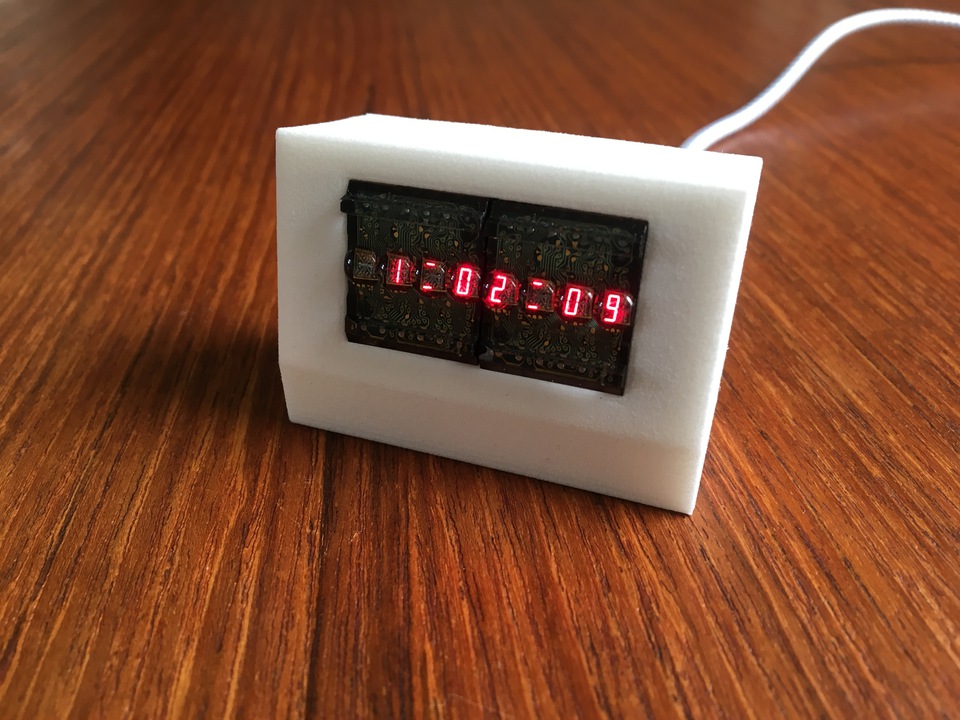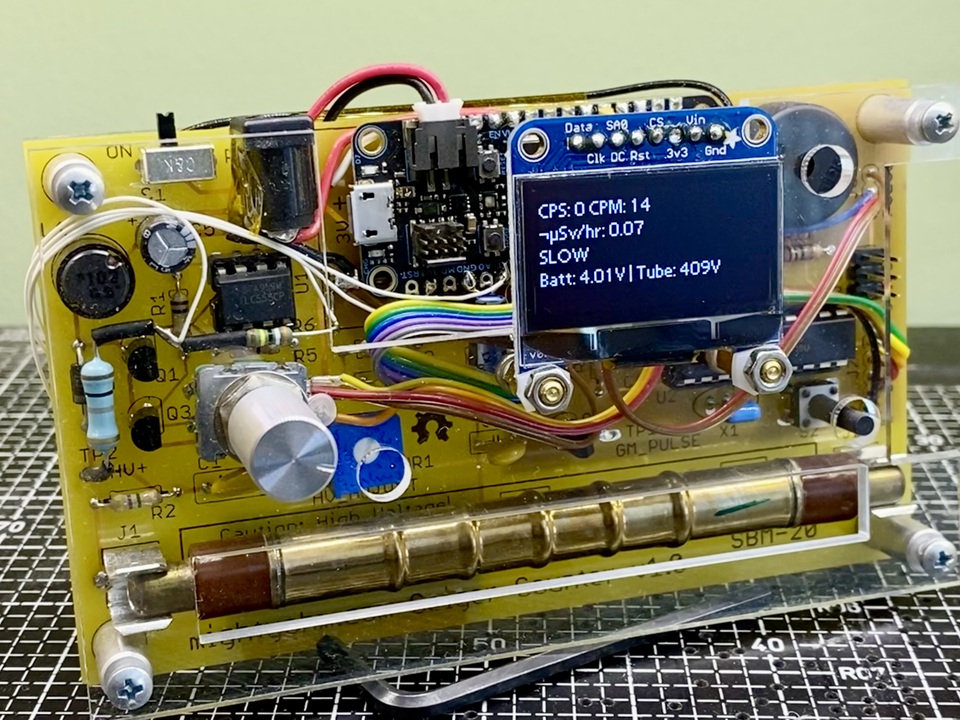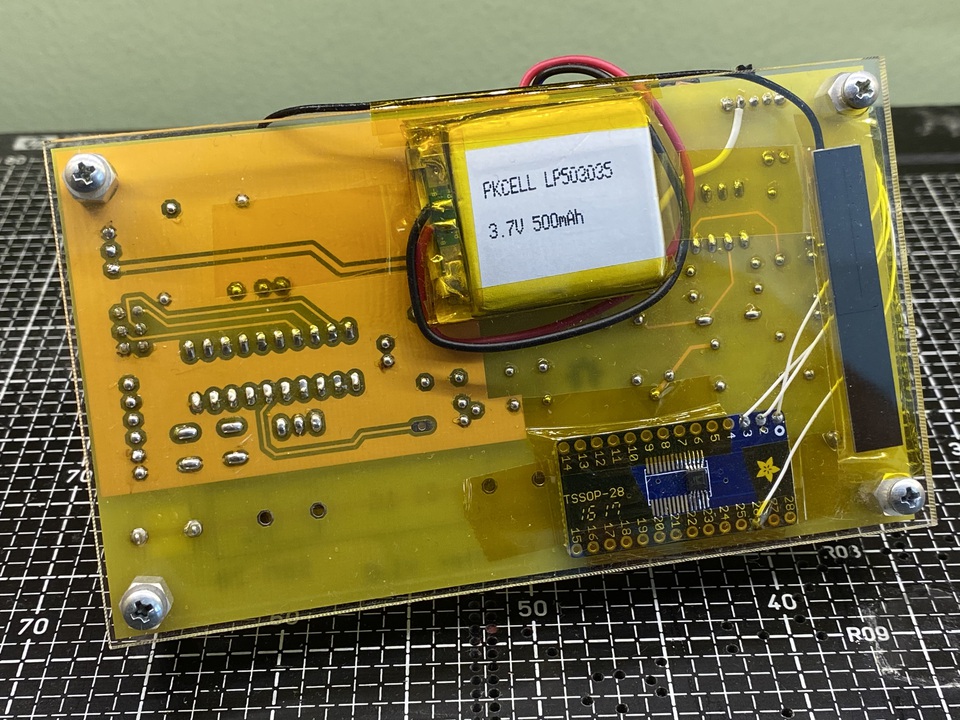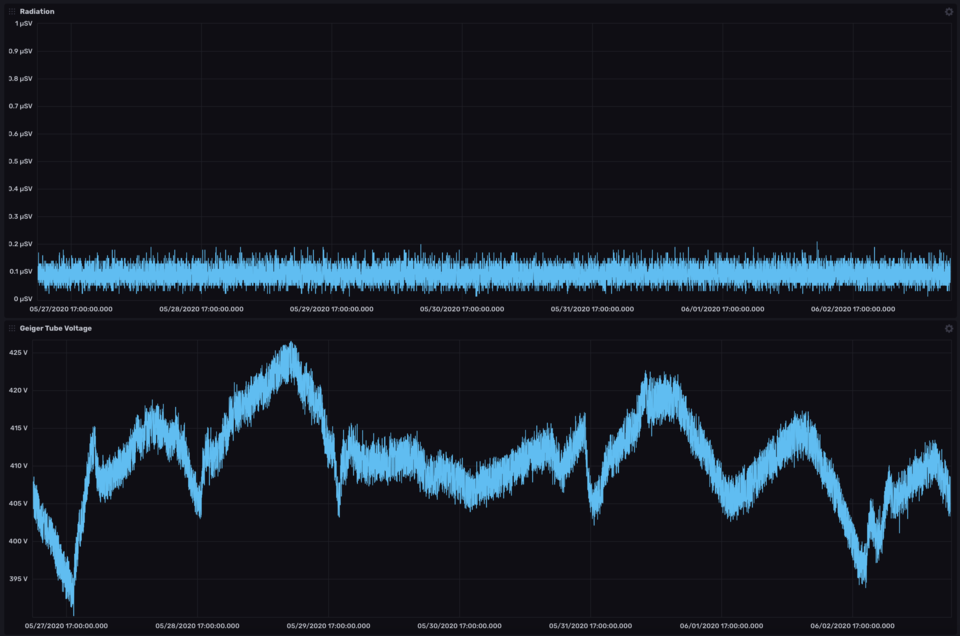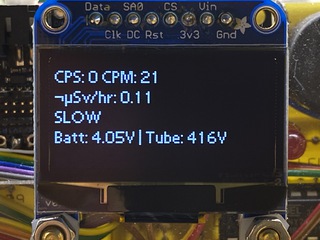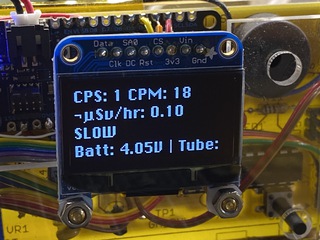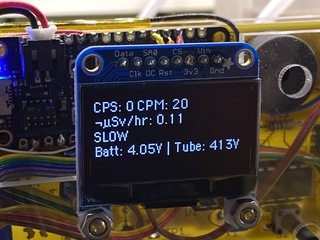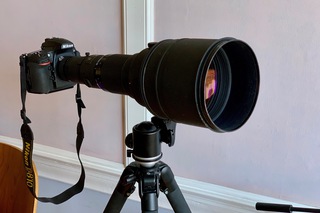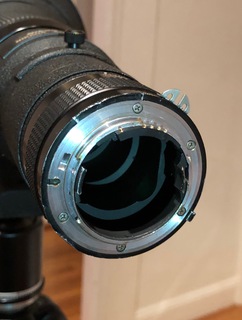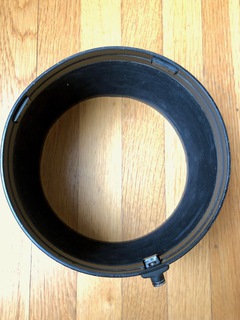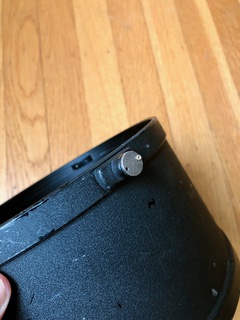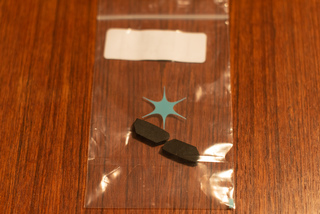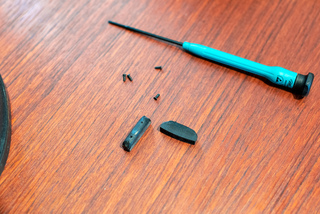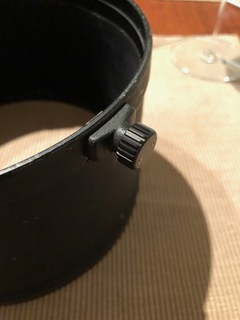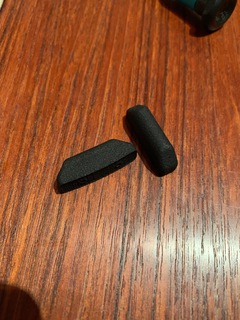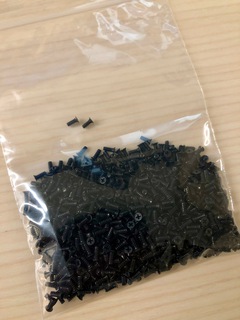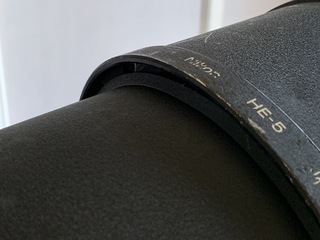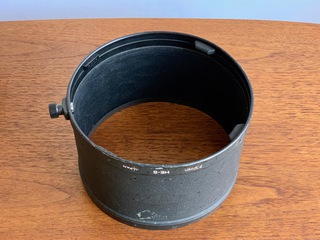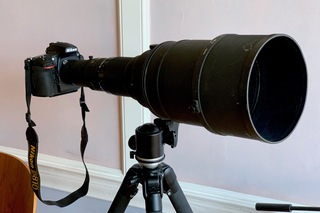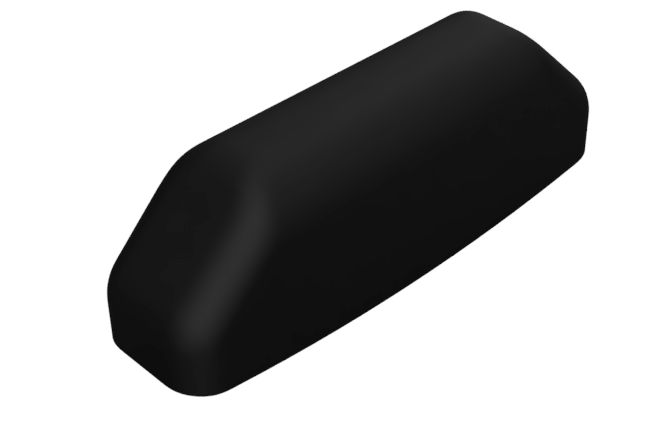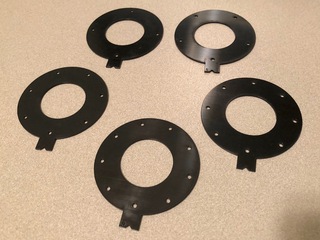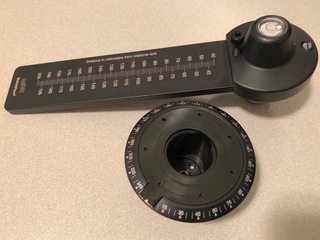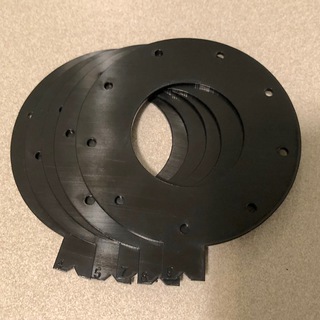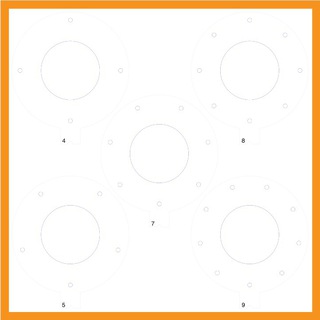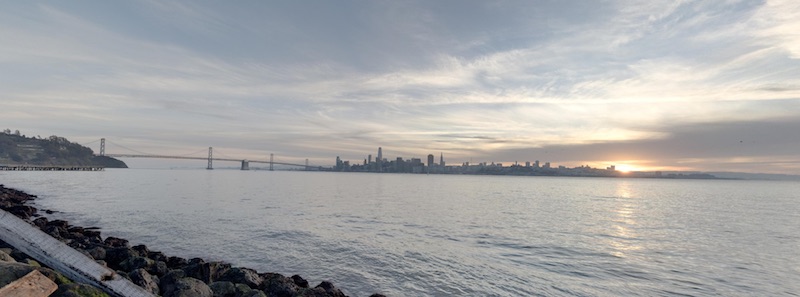Digital Clock DC-002
It seems like everybody interested in electronics ends up building a clock. I learned about the HPDL-1414 display module on Hackaday in 2014 and my fate was set.
I built Digital Clock DC-001 as a gift in 2015, then made a batch of eight DC-002 units in 2016, also to give away as gifts. A big part of what made it interesting for me was to expand beyond the circuitry to an enclosure and packaging.
As a little bit of a relaunch to this website, I've finally finished writing up the DC-002 clock project and published it here. It was always the plan to document the build; I'm happy to have completed that goal even after such a long wait.
MightyOhm Geiger Counter Enhancements
This post was migrated from a Twitter thread with minor edits. I back-dated it to the original date of publication; first publication on this site in December 2022.
I had a really fun time building the Geiger Counter kit from MightyOhm while at home during pandemic lockdown and explored some neat enhancements.
I added an Adafruit 128x64 graphical OLED display, Particle Argon WiFi microcontroller, LiPo battery pack, and tube voltage monitoring circuit. It features an Analog Devices AD8244 high-input-impedance buffer and a 1 GΩ/3.9 MΩ voltage divider to connect to an ADC pin on the Argon.
I started logging tube voltage, battery voltage, and radiation levels to InfluxDB and noticed something interesting—the tube voltage is highly temperature dependent. Doesn’t seem to affect the radiation measurement though!
I’ve got some ideas to improve the display with a nice graph, and implement a dynamic algorithm to change the integration time automatically based on radiation level, leveraging the horsepower of the Argon.
Oh yeah, and I converted some classic Mac fonts to use with the Adafruit_GFX library—Espy Sans, Chicago, and Geneva—for the ultimate UI bitmap font style.
Michele is a fan of the Chicago version, IIRC. :)
Nikon HE-5 Lens Hood Extension
My foray back into panoramic photography gave me an excuse to buy a DSLR. Owning a DSLR has given me an excuse to search eBay for deals on interesting camera lenses. In December that led to the purchase of a Nikon 600mm f/4 AiS manual focus super-telephoto lens. My particular copy appears to have been owned by the Dallas Morning News at some point—as that's written on the side of its trunk case. I trust it is a good retirement activity for this lens to look at birds and airplanes; activities which I also enjoy. It's incredibly heavy and impractical to carry around, but along with my modified TC-20E III, it's pretty much like looking through a telescope. I also added a dandelion CPU to the lens to get some of the benefits of more modern kit, like focus priority shutter and EXIF lens info.
That excellent eBay deal unfortunately meant there were a few compromises, like the beat up case. The most significant was that the lens was missing the HE-5 Hood Extension. Having such a large front element meant that it's tricky to shade the front element from incident sun exposure, which can cause washed out images and lens flare. It took about 6 months to find a hood on eBay, so I bought the first one I ran across, even bidding it up while on vacation.
I was elated to finally complete my kit by adding this part—but it turned out upon receipt, the hood extension wouldn't mount to the end of my lens. After a bit more research online, I was able to determine there were 2 plastic mounting tabs missing from the hood. These were subtle and frankly I hadn't noticed them on any pictures of hoods while researching and purchasing the hood online. The seller was happy to help get things straightened out, but had no ability to magically conjure up these parts. I decided that instead this would be an opportunity to restore a rare old piece of equipment and keep it from the scrap heap. The missing knob was easy (albeit expensive) to come by from Nikon, as the part is still used on modern lenses. The screw on the new ones is a bit longer, so I just removed the black aluminum cap and screwed it into place. Next were those pesky tabs. I knew it'd be impossible to find original tabs I needed, so I studied all the photos I could find, approximated what size they'd need to be to mount the lens, and started modeling in Fusion 360. I asked for some help on the DPReview forums, and got some help from the community there. A quick trip to the Shapeways website, and I had my first revision in hand.
Of course the first revision didn't fit, so I sanded them down, made them work, and modeled up the second revision. This time shrinking the tabs and rounding them off for easier mounting. The trimmed down version worked like a charm, and Shapeways was very kind in replacing one of the two that came out a bit deformed from the printer. Their new Professional Plastic (HP PA12 Nylon Plastic) is extremely durable and seems like it'll be perfect for this kind of mechanical part. The final trick was locating original screws to match the 25-year-old ones in the hood. This one was trickier than expected. While it was soon clear the screw diameter was M2 and length was 5 or 6mm, I couldn't quite make sense of the 0.6mm thread pitch and kept questioning my caliper measurements. I spent about a week searching through different screw standard specifications until I finally encountered the JCIS Type-B Thread Forming screw. It turns out this screw is specially designed to be self tapping, and the body of the screw is in fact more like a rounded-off triangle than a cylinder—a design I eventually learned was called "trilobular." Of course it had a standard JIS cross point (not philips) drive and was black in color. Knowing the screw specs was helpful but not sufficient because however hard I tried, I couldn't find a supplier in the US. Eventually Saima Corporation in Japan responded favorably to an inquiry for a quote, and I soon had 1000 of exactly the screw I needed. (Please let me know if you need any of the 996 remaining screws I now own…) They were an excellent help to completing this project.I still have a bit of restoration to do on the 600mm f/4 AiS. I need to craft a workable lens cap and the rubber ring on the end of the lens is still missing (anybody know of reputable 3d-gasket printing outfit?), but these all seem doable now that I've got a working hood extension!
I'm looking forward to more birding expeditions this fall, no matter the angle of the sun. :)
Kaidan QuickPan IV Detent Discs
Recently I've been getting back into panoramic photography. It's been a lot of fun, after perhaps a decade long hiatus, to capture spherical panoramas again. I picked up a mint condition Kaidan QuickPan IV tripod head with Spherical Bracket to relive my early 00's QTVR days, while securely mounting my new Nikon D810 camera when capturing photos.
In order to capture a panorama I use the tripod head to take evenly spaced photographs in all directions. It uses small plastic disks to click into the right position, so the photos are easily aligned.
It works great, but I found that I needed a different set of detent discs than came with the tripod head. I think there was some standard set—but to achieve 25% overlap with my 17-35mm lens, I calculated 7 photos would be optimal, but that value wasn't included in the kit.
I figured it would be nearly impossible to find additional Kaidan detent discs since the company is now defunct, so I set about making my own through Ponoko. I used my vintage Browne & Sharpe Dial Caliper to measure the original discs, then drew up some new ones using Inkscape. Ponoko gave me a $20 coupon for signing up, so I got my set of 5 laser-cut discs for less than $10 shipping & handling. The quality is excellent, and the 1.5mm Delrin material is perfect for the discs.
The fit is a bit snug, but they work great! I've made the discs available for purchase through Ponoko here, and also am providing the design file for download here. While it's unlikely many folks are looking for detent discs for the long discontinued QuickPan IV tripod head, I figured it'd be nice to have some source to get them in case anybody needs replacements.
I haven't yet captured a panorama with my new discs, but last weekend I went to Treasure Island and recorded the image below. I'm still working on HDR, color, and stitching details, but still happy with the results.
Place Matrix
Reddit put together what was ostensibly an April Fools' joke that allowed users to "place" one pixel at a time on a large canvas. It turned out to be a really awesome social art project; groups needed to collaborate to get anything done because there was a long delay between opportunities to place pixels.
Update: Incidentally, Reddit published a great article today about how they built r/Place. Highly recommended.
Update 2: I wrote a technical description of how I built Place Matrix.
Because I'm not a big Redditor, my friend Andrew showed this to me, I think after a post on Twitter. We had a great discussion about the emergent behaviors that occurred with such a simple system on Saturday night, and talked about how such constraints can make things a lot of fun. I had just finished building my p11-matrix project from Boldport Club, and had connected it to the web with an API that only allowed toggling a single pixel.
So the next day I woke up and realized I had to port Place over to meatspace and started hacking. Thanks Andrew for helping incubate the idea. I'm not a web programmer, but my Python skills aren't too bad so I found a tutorial on Medium and started setting up AWS Elastic Beanstalk. One full Sunday of programming (followed by 3 back-to-back late night debugging sessions…) and it works. Lots of thanks to my friend Charlie for help and support through these manic last couple of days, and to the Saar for making Boldport Club and inspring projects.
Check it out at Place Matrix.
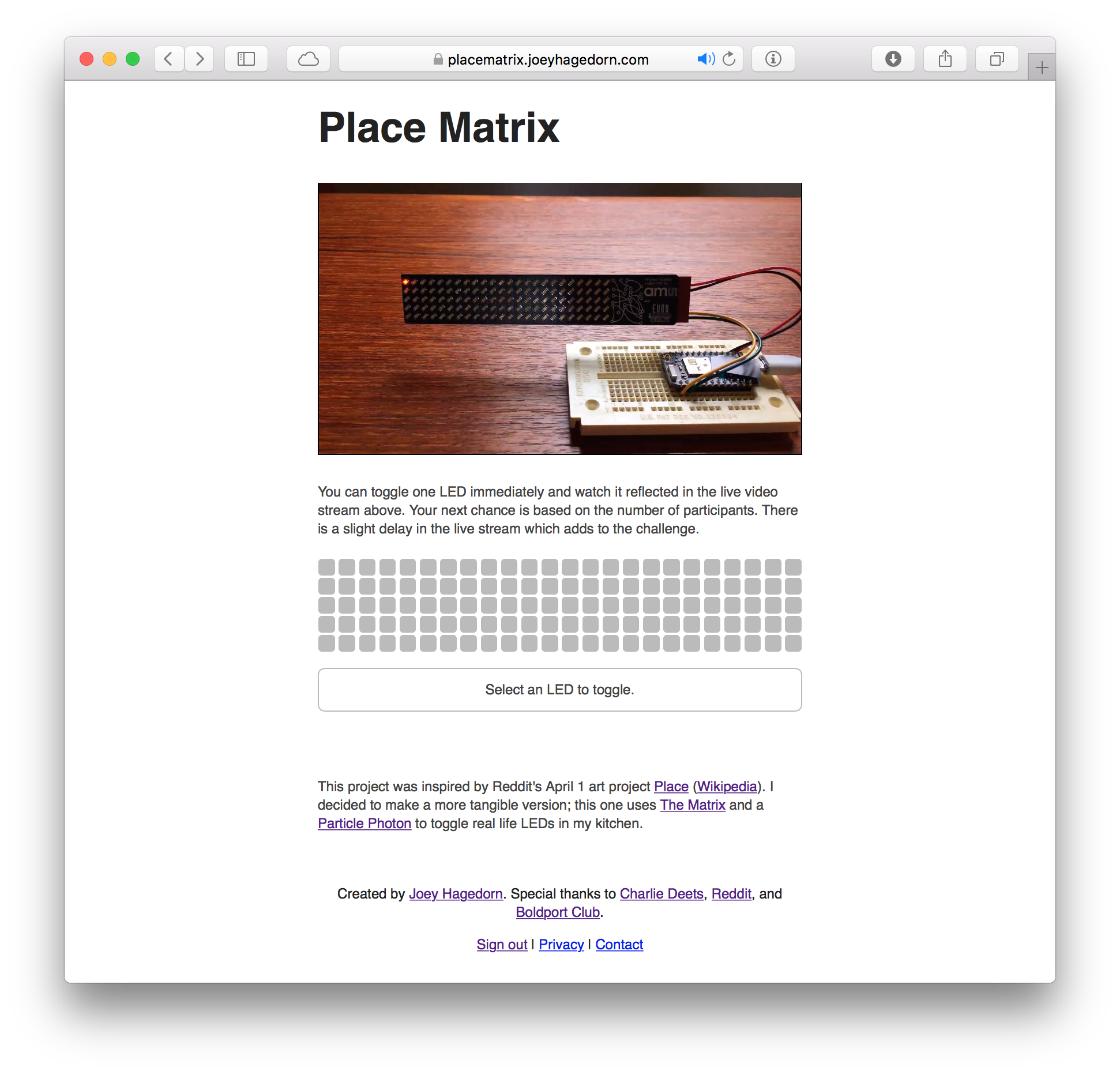
(enlarge)
subscribe via RSS
